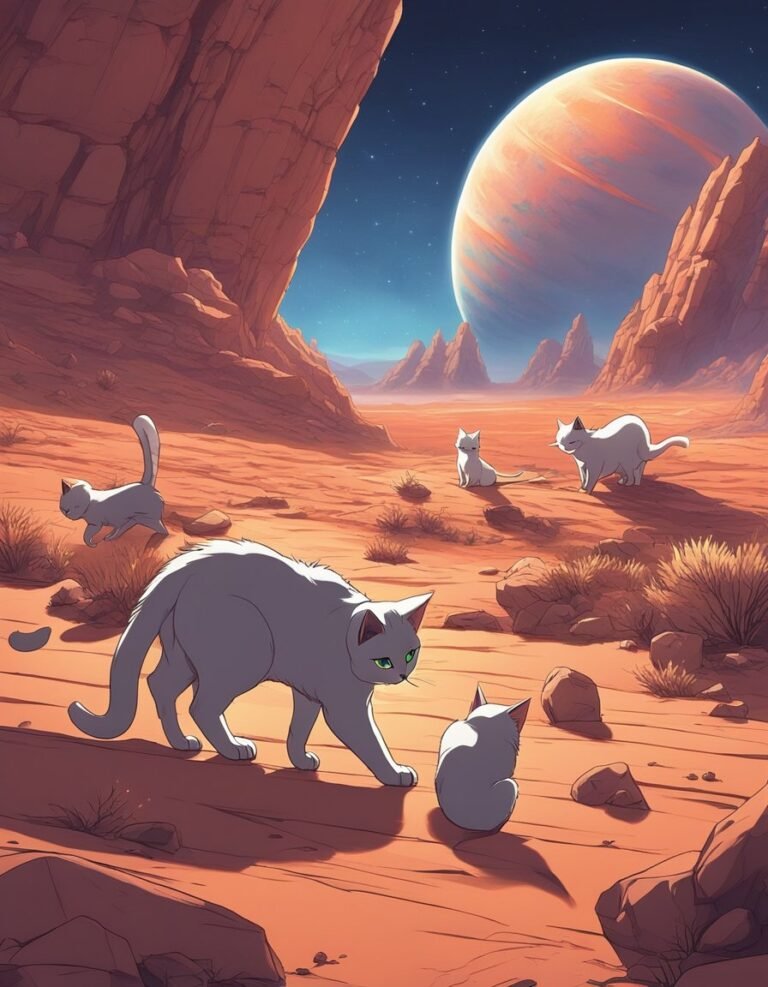Cats on Mars: Space Felines Explore the Red Planet

Exploring the curious intersection of felines and the final frontier, “Cats on Mars: Space Felines,” delves into an imaginative world where cats aren’t just confined to our living rooms or backyards but are also part of spaceflight narratives.
It’s a topic that combines the whimsy of our furry friends with the serious scientific endeavor of sending probes to Mars.
NASA’s advances in space exploration and the possibility of Mars colonization prompt the question: what role could cats, one of humanity’s oldest companions, play in such a monumental step for humankind?

Weaving playful humor with scientific intrigue, the idea extends beyond the literal to encompass the various ways in which cats infiltrate our cultural depiction of space.
This includes everything from engaging gaming experiences where you can play as a dancing space cat, to creative thought experiments about pets joining us on interplanetary adventures.
The fascination with cats and their hypothetical space voyages reflects our love for these enigmatic creatures and our ever-present desire to push beyond the boundaries of Earth.
With initiatives like NASA’s ultra-high-definition streaming of a cat video from space, one thing is certain: the allure of cats is universal, whether they’re chasing a laser pointer on Earth or becoming the poster animals for revolutionary communication technology from millions of kilometers away.
The charm of felines combined with the awe of the cosmos creates a compelling narrative, sparking imagination about what life with our pets might look like in the extraterrestrial realm of Mars.
Journey to the Red Planet

Buckle up, because you’re about to discover how cats are turning into space pioneers.
You’ll learn about crafting the perfect kitty-friendly spaceship, training feline astronauts, and the excitement of rocket launches.
Preparing the Purr-fect Spacecraft
Your mission begins with creating a spacecraft that suits the unique needs of your whiskered crew. Spaceship design must take into account comfort and safety for your feline passengers.
Everything from temperature controls to zero-gravity litter boxes must be thought out.
Mission control works with physics experts to ensure the vessel is ready for the stresses of launch and the harshness of space.
- Hull Integrity: The spacecraft’s hull must resist meteoroids and radiation.
- Life Support: Oxygen, water, and food systems must function flawlessly.
- Cat Comforts: Specialized areas designed for cats to relax and exercise.
Space Training for Feline Astronauts
Getting your cats ready for space is no small feat.
You’re gonna need to think about training regimens that acclimate them to the sights, sounds, and sensations of space travel.
This includes getting used to the sounds of rocket launches and the feeling of being in a spaceship for an extended period.
- Zero-G Etiquette: Float like a cat, gracefully and with precision.
- Emergency Procedures: Training for uncommon but possible scenarios.
- Sherp-fitting: Ensuring spacesuits fit just right for maximum mobility.
Rocket Launches and Trajectory
When launch day arrives, the energy is palpable.
Your cats, now well-trained astronauts, are poised to ride a controlled explosion all the way to the Red Planet.
The rocket launch is a stunning display of power and physics.
Every bit of thrust is calculated for a precise trajectory that will sling your furry explorers to Mars.
- Countdown: The final moments are filled with anticipation and last checks.
- Liftoff: As the rocket soars, every shaking moment is monitored back at mission control.
- Orbital Insertion: A critical phase when adjustments ensure Mars is firmly in your sights.
From the initial space capsule design to the thrill of launch, your cat’s journey to the Red Planet is a meticulous blend of space news headlines and scientific achievement.
So, get your space suits ready, and don’t forget the catnip!
Life on Mars

You’re on the brink of a cosmic shift in pet care, envisioning a future where your feline friends roam the red planet.
Think space-age litter boxes and zero-gravity catnaps.
Creating a Cat-Friendly Martian Colony
Making Mars hospitable for cats isn’t just sci-fi fantasy; it’s an intricate blend of science and creature comfort.
First up, habitat design: imagine climate-controlled domes with Earth-like conditions, complete with artificial gravity to keep those kitty zoomies in check.
Cat trees might be replaced with space-saving cat shelves, ideal for compact Martian homes.
Cat Behavior and Health on Mars
Health is paramount, and on Mars, the game changes.
Cats will need specialized diets formulated for lower gravity environments.
Veterinary science advances to monitor feline wellbeing, considering Martian dust and its effects on kitten respiratory systems.
Your cat’s instincts may shift; there’s no telling how they’ll react to Mars’ dark skies and alien geography.
Interplanetary Relations: Cats and Aliens
If Martians do exist, setting the stage for peaceful interplanetary relations is key.
Introduce your cats to the cosmos as ambassadors of Earthly wildlife.
Who knows, perhaps in the universal cafeteria, waffles might become a shared favorite between cats and aliens, symbolizing a quirky yet harmonious cosmic connection.
Throughout this journey, as you turn your gaze from the moon to the greater cosmos, remember you’re not just a cat lover—you’re a trailblazer in the new age of science journalism within the domestic frontier.






